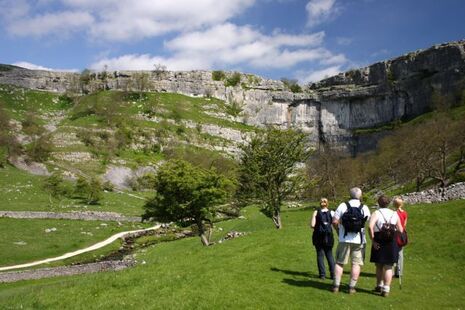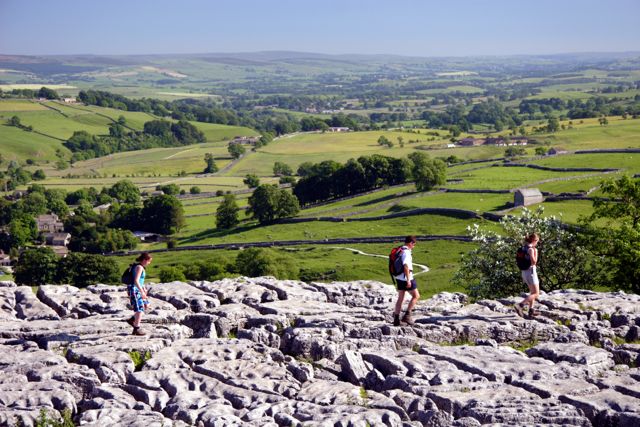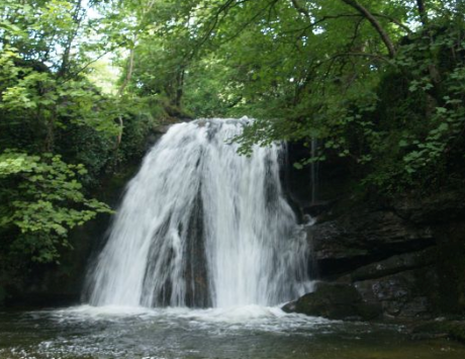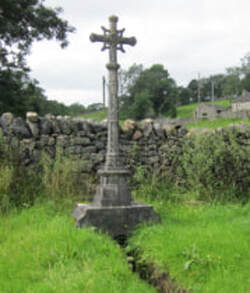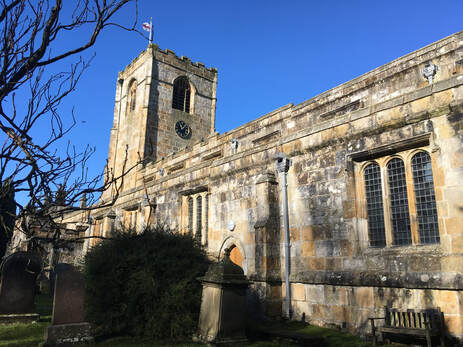Things to do in Malham and Malhamdale
Limestone PavementsMalham Cove is a popular spot, and many visitors climb the steep steps to the famous limestone pavement. Most visitors think of this as a photogenic curiosity, little realizing just how special is this habitat. Limestone pavements are quite rare and the majority of them in Britain are to be found in the Yorkshire Dales National Park and Cumbria. You can find them in other areas of Malhamdale, Ribblesdale near Ingleton and White Scar Cave, Crummackdale, and above Austwick on Moughton. They're often on the top of scars or limestone cliffs, a startling plateau of limestone rock, weathered by centuries of wind and rain.
Limestone pavements were first formed by ice sheets which effectively scoured the limestone rock. The block-like pavement effect comes from the clints and grikes in the blocks of limestone. The clints are the flat slabs of limestone and the grikes the cracks between them which have been widened by water over time. It's this combination that makes such an important habitat. Plants that love light grow along the clints and those that prefer shade grow in the grikes, out of reach of grazing animals. Several ferns such as hart's-tongue, limestone fern, buckler-fern and holly fern all grow there as well as plants like rock-rose and bloody crane's-bill. There are Limestone Pavement Orders in place to protect this biodiversity. Janet's FossMost visitors head off towards Malham Cove, missing out on the delights of Janet's Foss. Foss means force or waterfall, probably an old nordic name. It's not a big waterfall but it does seem to hold visitors spellbound.
The pool was once used for sheep dipping. Now it's simply a lovely spot for wild swimming or just to sit and enjoy the beauty. It's best to park in the National Park Car Park and then follow the signs to enjoy the approach to the woodland waterfall. . A little way down the path from the waterfall are a couple of tree stumps with hundreds of pennies pressed into them. Add a coin of your own and make a wish to the queen of the fairies. Why is it named after Janet and who is she? Janet is the Queen of the Fairies and lives in a cave behind the waterfall. I think you can tell this is a special enchanted spot thanks to the vivid greens, mossy tufa screen and dappled light. This wooded area is rich in wildflowers, ferns, mosses and birdlife, making it feel like a magical gathering place for all that's most beautiful in the Yorkshire Dales
It's said that the cave was once inhabited by copper workers working a local mine. Their lives would have been a hard slog but given the beauty of this bewitching little spot, it's tempting to imagine them wearing brightly coloured outfits and singing as they went off to work like the Seven Dwarves. Kirkby MalhamMalham lies on the River Aire, a short distance from Malham. It's so small that most people simply pass through on their way to better known beauty spots, and yet despite its size, Kirkby Malham has a cornucopia of interesting connections and curiosities.
Kirkby Malham has been the home of numerous literary greats including Bill Bryson, the American author of the best-selling Notes from A Small Island lived and Charles Kingsley who immortalized the church bells in The Water Babies (1863). The church of St Michael the Archangel is sometimes called 'the Cathedral of the Dales'. Its foundation goes back to the 9th century, with the church being rebuilt in the 15th century. It's a fascinating church to look around, said to have been visited twice by Cromwell to attend weddings. Like much of the Yorkshire Dales there is evidence that links the church with the monks at Fountains Abbey as much of the land was once owned by the Cistercian monks. |
Malhamdale is famous for its limestone pavements and crags. The natural limestone amphitheatre of Malham Cove has inspired countless poets and writers. J.M.W. Turner spent time sketching at Malham Tarn, England’s highest freshwater lake and Charles Kingsley wrote 'The Water-Babies' whilst at Tarn House.
A unique range of flora grows between the clints and grikes on the limestone pavements, protected from the grazing sheep. Malham VillagePark by the Yorkshire Dales National Park Centre, which has plenty of information about the area: they can also suggest more off-the-beaten track walks. Enjoy a wander around the village, criss-crossing the beck by the fords and ancient small bridges. There’s a short woodland walk, where you might spot some strange and huge animal footprints, and you can peek inside Malham Smithy and see Annabelle the Blacksmith at work. Look out for the old sheep pinfold too.
Malham PeregrinesIn late March each year volunteers and staff from the RSPB and Yorkshire Dales National Park start to set up their telescopes at the base of Malham Cove. They've been doing this for 17 years now, offering members of the public the chance to see the Malham Peregrine Falcons for five days a week from Thursday to Monday.
Apparently the Peregrines are the fastest animal in the world - when they swoop, they can reach speeds of over 200 miles an hour. Luckily they slow down a little during nesting season, and are relatively easy to spot at Malham with the help of the volunteers and their telescopes. Other stunning species can also be spotted such as Kestrels and Woodpeckers- all of which are worth a tweet. The Malham Peregrine Project has been rather successful with over 60 young raised since 1993. Goredale ScarGoredale Scar often catches visitors by surprise as it is only visible once you’ve got closer to it. It is believed to be around 15 million years old, formed during the ice age when glacial meltwater cut through rock faults. Over time the force of the water carved out the gorge.
An interesting feature is the tufa, crust-like deposits found on the rocks, created by the dissolved limestone in the water splashed down in the waterfall. Gordale Scar is at the end of 20 mile fault line, known as the Craven Fault stretching from Cumbria into the Dales. Gordale is a sight to behold all year round, stunning in dry weather and dramatic after rain as the waterfall gushes down the limestone gorge. The best way to enjoy Gordale Scar is to park at the Malham National Park Centre and call in for their walking route suggestion, including their Malham Landscape trail and Miles without Stiles booklets. AirtonThe Airton Meeting House near Malham is a wonderful oasis, historic and atmospheric. It's open to all, free of charge. It is the perfect place to sit quietly and relax in its peaceful surroundings.
It's still in use as a Quaker meeting house but you don't have to be a Quaker to go there. It's a lovely welcoming space. There are even fleeces on the seats and blankets for a real sense of comfort! The outside bench has a reassuring message: "all will be well". You can enjoy a quiet moment in the former seventeenth century barn, or if you wish to you can stay longer in the adjoining simple accommodation. Close by is the excellent Town End Farm Shop and Cafe, run by fifth generation butcher, Chris Wildman who also makes Yorkshire Chorizo |
Just inside the church gates are the old village stocks. I've often seen double stocks but don't think I've ever seen a triple set like these - they're incredibly close together so miscreants were either all very skinny or children?
Also in the graveyard is an another curiosity, known as the 'Watery Grave'. Colonel John Harrison had a career in his army so he was often separated by water from his wife Helen. She had asked ‘as water parted us in life, so it shall in death'. Helen's grave was built over a small stream running through the graveyard, with the intention that her husband would be buried on the other side of the stream. But when the Colonel died, try as he might, the gravedigger couldn't manage to dig beyond the impenetrable rock to create a separate grave, so he had to be buried with his wife.
The large and handsome mill building on the Aire gives an indication of Kirkby Malham's former importance. Known as both Scalegill Mill and Hanlith Mill, it was originally used to grind corn, and then either re-built or adapted to take advantage of the cotton boom in the 1790s.
By 1821 the building has been taken on by Dewhirsts. I remember learning to sew using Dewhirst Sylko cotton (although that wasn't until the 20th century...). In later years as the demand for cotton reduced the mill was used as a sawmill and eventually to provide electricity for nearby Hanlith Hall. After this the mill was taken over for poultry farming and then housing in 1975.
Also in the graveyard is an another curiosity, known as the 'Watery Grave'. Colonel John Harrison had a career in his army so he was often separated by water from his wife Helen. She had asked ‘as water parted us in life, so it shall in death'. Helen's grave was built over a small stream running through the graveyard, with the intention that her husband would be buried on the other side of the stream. But when the Colonel died, try as he might, the gravedigger couldn't manage to dig beyond the impenetrable rock to create a separate grave, so he had to be buried with his wife.
The large and handsome mill building on the Aire gives an indication of Kirkby Malham's former importance. Known as both Scalegill Mill and Hanlith Mill, it was originally used to grind corn, and then either re-built or adapted to take advantage of the cotton boom in the 1790s.
By 1821 the building has been taken on by Dewhirsts. I remember learning to sew using Dewhirst Sylko cotton (although that wasn't until the 20th century...). In later years as the demand for cotton reduced the mill was used as a sawmill and eventually to provide electricity for nearby Hanlith Hall. After this the mill was taken over for poultry farming and then housing in 1975.

